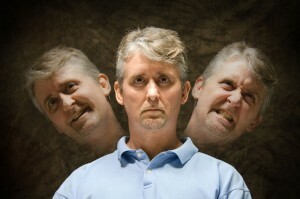 Schizoaffective disorder( periodic schizophrenia) is a condition that has a favorable course and combines the symptoms of schizophrenia and affective disorders.
Schizoaffective disorder( periodic schizophrenia) is a condition that has a favorable course and combines the symptoms of schizophrenia and affective disorders.
It is characterized by periods of remission and exacerbations. According to ICD-10, this condition is not isolated as an independent disease, but is considered as a paroxysmal disorder of the psyche.
Content
- General characteristics
- history
- diagnosis formation Causes of mental disorders
- variants of
- nature of clinical
- Common signs with
- schizophrenia Common symptoms of affective disorders
- Behavior of patient
- Diagnostic criteria
- therapy methods
- Preventive
measures General characteristics
schizoaffective psychosis(recurrent, circular schizophrenia) is a slowly progressive disorder manifesting psychotypeseskimi attacks and severe affective disorder or schizophrenia.
The psychosis is characterized by a long current and negatively affects all aspects of life. The dynamics of seizures is the simultaneous coexistence or sequential development of periods of depression and mania.
The complex of symptoms includes not only an affective disorder, but also signs of schizophrenia that manifest themselves in varying degrees and have different duration of flow.
History of the diagnosis of
The term "schizoaffective disorder" itself was introduced in 1933.Even earlier, Kleist described cycloid psychoses, which in  subsequently took their place, as corresponding to schizoaffective syndrome.
subsequently took their place, as corresponding to schizoaffective syndrome.
Already in 1957, attempts were made to integrate psychoaffective syndrome into one of the forms of endogenous psychosis. But after careful study it was established that this state of mind is an independent syndrome, and not a subtype.
Many psychiatrists believe that all recurrent psychoses, psychogenic schizophrenia, cycloid psychosis and psycho-affective disorders have similar causes, symptoms, forms and conditions.
That's why previously this condition was diagnosed as one of the types of psychosis. But over time, medicine needed a narrower demarcation of these concepts.
Causes of mental disorders
To date, the causes of the development of mental disorders of this type are not fully understood. But on the basis of many years of research it was possible to discover a number of patterns that are relevant to the onset of the syndrome. These include:
- Genetic predisposition .In patients with established schizoaffective disorder, the immediate relatives of
 had schizophrenia or bipolar disorder.
had schizophrenia or bipolar disorder. - Lifestyle .Many patients are single people who have a fairly small circle of communication, are absent or far away relatives live. Pathology develops in the absence of moral support from loved ones.
- Abuse of alcoholic beverages or narcotic substances .Drunkenness and drug addiction negatively affect the functioning of the brain, killing its cells. But scientists have not revealed what is the primary factor, and what is secondary. After all, most of the patients start drinking alcohol on the background of lack of support and understanding from the relatives, as well as the presence of unreasonable fears, depression, neuroses.
After research, scientists were able to determine the range of people at risk of developing the disease. The probability of occurrence of circular schizophrenia is much higher:
- in women;
- in persons aged 18 years;
- in people living in large cities;
- in people experiencing frequent nervous breakdowns, depression.
Residents of large cities are most prone to developing neurological diseases. This is due to constant stresses, emotional tension and the rhythm of life.
Variants of
There are several types of schizoaffective psychosis, depending on the causes of the appearance and nature of the course of the disease.
Schizoaffective disorder can occur in the following forms:
- manic type is characterized by a mania of persecution, greatness;
- depressive type occurs against a background of frequent depressions and nervous overstrain, symptoms of prolonged depression are noted;
- mixed type differs mixed symptomatology of the previous two.
Each type of disease exhibits certain symptoms. Treatment also depends on the type of disorders.
The nature of the clinical picture
Schizoaffective psychosis has symptoms of both schizophrenia and affective disorder. But also there are similar symptoms, among them disturbance of motor activity, the presence of delusional and manic ideas, behavior changes.
Common signs with schizophrenia
The patient often seems to be overheard by someone who is an outsider. Also to symptoms that are similar to schizophrenia are:
- Hallucinations .The patient hears various voices that discuss or comment on his behavior.

- Delusions of the .In their content they are fantastic. For example, a patient may believe that with the help of his thoughts he can control the weather.
- Loss of the meaning of speech .There are new non-existent words.
- In addition, the catatonic features of the are manifested: the patient can suddenly freeze in one place or make a move opposite to that required from him.
General symptoms with affective disorders
The manic type of affective disorders exhibits the following symptoms:
- Motor activity significantly increases .
- Accelerated speech rate .During the conversation, the patient constantly jumps from one topic to another, while there are no direct connections between them.
- Sleep time is less than .There is insomnia or an unreasonable awakening in the middle of the night.
- Sexual activity is increased by .The choice of a sexual partner is not justified. These people are marked by a large number of sexual relationships.
- Plans that the patient builds for the future are truly grandiose , but are limited to words only. They do not reach their logical conclusion.
Manic type is characterized by the presence of ideas of self-blame, when patients feel that they are in some way to blame.
Depressive type is characterized by the following manifestations:
- retardation;
- after waking up a depressed mood;
- work, which previously gave pleasure, becomes boring and unpleasant;
- decreased sexual desire, appetite.
With a mixed type, there is a change in depressive and manic symptoms.
Features of the patient's behavior
 The patient may hear extraneous voices. He begins to be haunted by the thought that he is being eavesdropped. There are delusions of various ideas. For example, it may seem to him that he is able to control the objects and even the behavior of people by the power of thought.
The patient may hear extraneous voices. He begins to be haunted by the thought that he is being eavesdropped. There are delusions of various ideas. For example, it may seem to him that he is able to control the objects and even the behavior of people by the power of thought.
Behavior of people with a disorder is reckless, sexual activity increases or decreases depending on the type of disorders, sleep time decreases. Such people are characterized by an awakening in the middle of the night for no apparent reason.
In addition, weight loss is observed, the pace of thinking and speech is changing. There may be ideas of self-blame. Such people believe that they are guilty of something.
Diagnostic Criteria
To establish the diagnosis, the doctor carefully studies the patient's medical history and pays attention to physical health. A laboratory blood test, X-ray examination and psychological tests are also conducted.
If there are no reasons for the symptoms of the syndrome, the patient is referred for advice to a psychologist or psychiatrist.
Schizoaffective disorder is diagnosed if there are periods in which there are psychoses, mania, depression.
Methods of therapy
Treatment of schizoaffective disorder consists in prescribing drugs and conducting psychotherapy.
Drugs should be taken under the supervision of a doctor, since only a qualified specialist can choose the appropriate treatment regimen. The medicines that are used to diagnose circular schizophrenia include: 
- antipsychotics are used to relieve the symptoms of the disease;
- normotimics are intended to reduce the severity of violations;
- antidepressants are prescribed for the purpose of eliminating depression, to improve mood and stimulate physical activity.
The dose of drugs is also calculated by the doctor depending on the type of syndrome. In order to achieve results, follow the recommendations of a specialist.
Psychotherapy is used to eliminate the causes and factors that contribute to the development of the disorder. Begin the course of treatment should be after the release of their depressive state, when a critical attitude to the disease is formed.
In some cases, in the case of diagnosing schizoaffective disorder and in the absence of medical care, the prognosis is disappointing - depression, psychosis develop, suicidal thoughts develop. The disease has a negative impact on social, family, personal relationships, destroying them.
But even so, the outlook is generally favorable. However, schizoaffective syndrome has a wide range of opinions about its predictions. A certain group of specialists pay special attention to other indicators that are more significant when forecasting in each individual case.

Preventive measures
Specially developed methods of prevention do not exist. In order to avoid the development of pathology, it is necessary to undergo preventive examinations in a timely manner. Also, in order to prevent frequent outbreaks of the disorder, you should consult your doctor and be treated promptly.
Schizoaffective syndrome is a little studied disease, the exact causes of which are not established. Mental disorder has symptoms of schizophrenia and affective disorder, which complicates the diagnosis and treatment.



